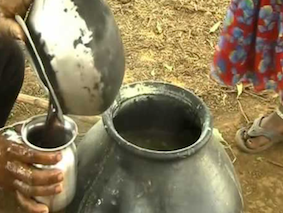 |
|||
| Organic Farming :: Organic Farming Practices | |||
MANAGING SOIL FERTILITY AND WATER REQUIREMENTSSoil Groundnut is a deep-rooted plant and hence uses both moisture and nutrients from the deeper layers of the soil. Nitrogen requirement in the rain-fed crop is 10–20 kg/ha and in the irrigated crop, 20–40 kg/ha. Phosphorus requirement for the rain-fed crop is 20 to 40 kg/ha and in the irrigated crop, 40 to 90 kg/ha. Although Indian soils are rich in potassium, the recommended dose is 20 to 40 kg/ha both for the rain-fed and the irrigated crop. The application of gypsum at the rate of 500 kg/ha at pegging stage will enhance pod fixation. In virgin lands, when groundnut is newly introduced, the application of a culture of rhizobium as seed treatment is beneficial for increasing nodulation and nitrogen fixation. Spraying buttermilk 25 and 35 days after sowing fetches good yields. It serves as a growth promoter. Three litres of buttermilk prepared by diluting 1⁄2 litre of curd is sprayed over the crop.
Water Depending on the soil texture, the frequency of irrigation will vary. However, irrigation must be given during the critical stages of growth like flowering, peg formation and pod development. In areas that receive 50–70 cm of rainfall, 2–3 irrigations should be given. For the rabi crop, 3–4 irrigations are necessary. In case of limited water availability, single irrigation at the time of flowering is compulsory. Irrigation of the plot just before harvesting will make the operation easier.
Source : Centre for Indian Knowledge Systems, Chennai Updated on : Dec 2014 |
|||
© 2009-16 TNAU. All Rights Reserved. |

